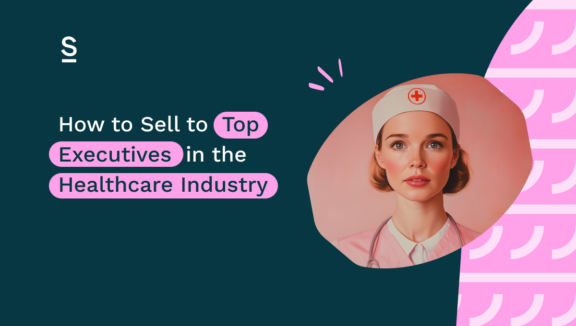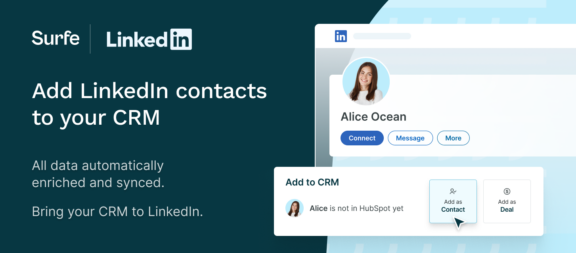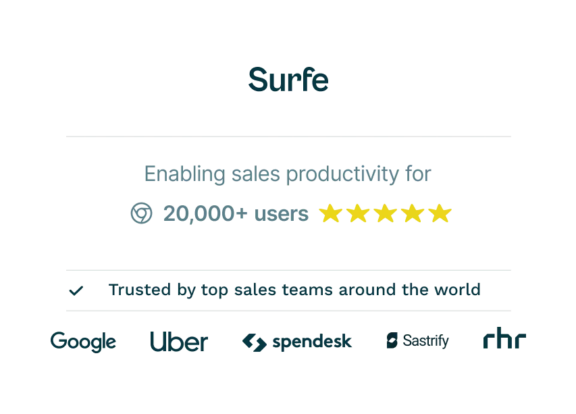How to Sell to Top Executives in the Healthcare Industry

Healthcare is an industry like no other. With executives under more scrutiny than perhaps all other sectors, every penny spent needs to be justified and deliver value for patients and shareholders. To have a chance of cutting through the noise and landing a sale with a healthcare leader, your sales proposition needs to be sensitively attuned to these complexities, and consider unique nuances and priorities of this highly regulated, complex, and rapidly evolving field.
Sounds like a headache? It can be. But with the right strategy, you can streamline your outreach efforts to decision-makers in the healthcare sector and start closing more details. Read on to find out how.
In this article, we’ll cover:
Diversify Your Sales Channel Mix
In the healthcare industry, decision-making is rarely a one-step process. The stakes are high, and decisions often require input from various stakeholders, including clinical staff, financial officers, and regulatory experts. That’s why a multi-touch, multi-channel sales strategy is crucial. This approach involves interacting with multiple prospects across multiple platforms—such as LinkedIn, email, and phone—at different times according to a well-planned schedule.
For instance, you might send a LinkedIn connection request on day 1 with a personalized note, follow up with a cold call on day 2, and then send a targeted email on day 3. The key is to be persistent without being intrusive, and to ensure each touchpoint adds value to the conversation.
Leveraging Social Selling on LinkedIn
LinkedIn is an essential tool for connecting with healthcare executives, but it’s not just about sending a message and hoping for a reply. In the healthcare sector, trust and credibility are paramount, so your approach needs to be thoughtful and deliberate.
Start by following your target executive and engaging with their content. Comment on their posts, share relevant articles, and gradually build a rapport. After establishing some familiarity, you can send a connection request with a brief, personalized note that highlights your mutual interests or connections. Once connected, continue to engage with their content before initiating a direct conversation. The goal is to nurture a relationship that leads to a natural and trust-based sales dialogue.
Tailoring Your LinkedIn Strategy for Healthcare Executives
When targeting healthcare executives, your LinkedIn messaging should be concise and focused on the specific challenges they face. For example, if you’re reaching out to a hospital administrator, your message could address how your solution can improve patient care outcomes or streamline hospital operations. For executives in pharmaceutical companies, emphasize how your product or service can accelerate drug development timelines or enhance regulatory compliance.
The tone should be professional and empathetic, acknowledging the pressures these executives face in a highly regulated and scrutinized environment. Short, impactful messages that demonstrate a deep understanding of the industry will resonate better than generic pitches.
Craft Compelling Cold Emails
Cold emailing can be a powerful tool when done correctly, especially in the healthcare sector where decision-makers are inundated with information. Your emails need to stand out by being highly relevant and personalized.
Key Components of a Successful Cold Email:
- Attention-Grabbing Subject Line: The subject line is your first and often only chance to make an impression. Use concise, benefit-driven language. For example, “Enhancing Patient Care with Cutting-Edge Tech” or “Streamlining Compliance in Healthcare Operations.”
- Personalization: Address the recipient by name and reference specific challenges their organization might be facing. If possible, mention recent news about their company or an industry trend that’s relevant to them.
- Value Proposition: Clearly articulate how your solution can address a pressing issue they face. For example, “Our software reduces patient data entry time by 50%, allowing your staff to focus more on patient care.”
- Call to Action (CTA): End with a clear and straightforward CTA. Whether it’s scheduling a call, attending a webinar, or downloading a whitepaper, make sure the next step is easy and valuable to the executive.
Follow-Up Sequences and Email Timing
Persistence is key in cold emailing, but timing and content are just as important. A typical follow-up sequence might involve sending an initial email, followed by a reminder email three days later, and then a final “breakup” email a week after that if there’s no response.
In the healthcare industry, executives often have packed schedules, so avoid sending emails early in the morning or late in the afternoon. Mid-morning or early afternoon is usually the best time to catch them when they’re likely to be checking their inboxes.
Cold Calling Tips for Healthcare Executives
- Research and Preparation: Before making the call, do your homework. Understand the executive’s role, the organization’s structure, and the specific challenges they might be facing. For example, if you’re calling the CIO of a hospital, be prepared to discuss how your technology can integrate with their existing systems and improve patient outcomes.
- Opening the Call: Your opening line should be brief, to the point, and relevant. For example, “Hi [Name], I’m [Your Name] from [Company]. We specialize in helping hospitals like yours reduce operational costs while improving patient care. I’d love to discuss how we can help you achieve your goals.”
- Handling Objections: Expect objections, and be prepared with responses that address their concerns. If the executive says they’re not interested, ask a follow-up question that uncovers the root of their objection. For instance, “I understand you’re busy. Could you share what’s currently your biggest challenge in [specific area]?”
- Gatekeeper Navigation: If you encounter a gatekeeper, treat them with respect and try to gather information that could help in your approach. For instance, you might ask, “Could you please confirm if [Executive’s Name] is the right person to speak with about improving operational efficiency?”
Managing Rejections and Persistence
Rejection is part of the game, but it doesn’t mean the end of the conversation. Always end on a positive note and leave the door open for future communication. For example, “I appreciate your time today, and if your priorities change, I’d love to continue the conversation at a later date.”
Persistence, without being pushy, is key. If you don’t get through the first time, try different times of day, or follow up with an email referencing your earlier call.
Integrating Channels for Maximum Impact
For maximum effectiveness, your sales strategy should integrate social selling, cold emailing, and cold calling into a cohesive plan. The healthcare industry is particularly sensitive to timing, so coordinating these efforts is crucial.
Example of a Coordinated Approach:
- Day 1: Send a LinkedIn connection request with a personalized note.
- Day 2: Follow up with a cold call to discuss how your solution can address a specific challenge they’re facing.
- Day 3: Send a cold email referencing your LinkedIn connection and call, providing additional information or resources.
This approach ensures that your prospect is consistently engaged across different channels, reinforcing your message and increasing the likelihood of a positive response.
Timing Your Touches
Timing is everything, especially in healthcare. Executives in this industry are under constant pressure and have limited time for unsolicited pitches. Your sequencing needs to be carefully planned to avoid overwhelming them while ensuring your message stays top-of-mind.
Use data from your CRM and buyer intent tools to determine the best times to reach out. For instance, if your CRM shows that a prospect typically opens emails in the afternoon, schedule your emails and follow-up calls accordingly.

Incorporating Buyer Intent Data into Your Strategy
Use buyer intent data to refine your multi-touch, multi-channel strategy. For example, if an executive has visited your website’s page on “Improving Hospital Efficiency,” you can tailor your next communication to address that specific interest.
Align your sales and marketing efforts to ensure that your messaging is consistent across all channels. If a prospect engages with a particular piece of content, follow up with related materials or a case study that demonstrates the effectiveness of your solution in a similar healthcare setting.
Adopt an Iterative Strategy
Successful sales teams understand the value in using test-and-learn to refine their outreach tactics. Continuously monitor buyer intent data to improve your strategy. If you notice that certain touchpoints are more effective than others, adjust your approach accordingly. For example, if your emails consistently receive high engagement, you might increase the frequency of your email outreach while reducing the number of cold calls.
Best Tools for Healthcare Sales
CRMs for Healthcare Sales
A robust CRM system is essential for managing relationships with healthcare executives. Look for features that allow you to track interactions, store important documents, and automate follow-ups. Integration with other tools, such as buyer intent platforms, is also crucial for a seamless sales process. (Did you know you can connect your CRM to LinkedIn with Surfe?)
Automated Outreach Tools
Tools like Outreach.io, Lemlist, and Salesloft can help automate your outreach efforts, allowing you to focus on high-value activities. These platforms can support your multi-touch strategy by automating follow-ups, tracking engagement, and providing insights into which touchpoints are most effective.
Buyer Intent Tools
We’ve already talked about the importance of buyer intent data, but which buyer intent tools allow you to analyze how far along your prospects are in the sales cycle? Platforms like Bombora or 6sense help gather and measure buyer intent data, enabling you to prioritize leads and tailor your outreach. Integrating these tools with your CRM ensures that your sales efforts are data-driven and aligned with your prospect’s needs.
Contact Data Enrichment Tools
Struggling to get the correct contact data for your lead lists? If you’ve gone to the trouble of trying to manually find accurate email addresses for senior executives on their website or social profile, you’ll know how time consuming this activity can be.
Surfe’s email finder has a 93% success rate in locating verified email addresses for your contacts. So you can avoid that dreaded bounceback notification when you send your outreach campaigns.
LinkedIn Sales Navigator
Are you getting the most out of LinkedIn Sales Navigator to really target the right decision-makers who will actually be able to buy from you? Use its advanced search features to find prospects based on specific criteria, such as their role, company size, or location. Sales Navigator also allows you to track prospects and receive alerts when they engage with your content, providing timely opportunities to reach out.

Crafting the Right Message for Healthcare Executives
Healthcare executives face unique challenges, such as regulatory compliance, cost control, and improving patient outcomes. Your messaging should directly address these pain points, demonstrating how your solution can help them achieve their goals.
If you’re selling a technology solution, for example, emphasize how it can reduce errors in patient data, improve compliance with regulations, or streamline operations to lower costs. Show that you understand the industry’s complexities and that your product is designed to meet those specific needs.
Value-Driven Communication
Healthcare executives are focused on value—whether that’s improving patient care, reducing costs, or enhancing operational efficiency. Your communication should clearly articulate the return on investment (ROI) your solution offers.
Use specific metrics or case studies to back up your claims. For instance, “Our solution has been shown to reduce patient admission times by 30%, allowing your hospital to treat more patients without compromising care quality.”
Building Trust and Credibility
Trust is a cornerstone of any relationship with healthcare executives. Establish your credibility by sharing relevant content, testimonials, and industry knowledge. Use social proof and case studies (without giving away too much detail) to reinforce your message.
For example, you might reference a case where your solution helped a similar healthcare organization achieve a significant improvement in patient satisfaction scores.
Let’s Wrap It Up!
Healthcare executives are under intense pressure to balance their budget and avoid unnecessary spending. Keep this in mind at all points of the sales cycle, and consistently show up in your outreach by clearly demonstrating the value your product or service delivers to patients, stakeholders and medical professionals.
By deploying a multi-touch, multi-channel strategy, leveraging buyer intent data, and using the right tools, you can effectively build your prospect’s trust to get them one step closer to investing in your product or service.

Need help finding verified email addresses for healthcare executives?
Surfe’s email finder has an unmatched 93% success rate.
Frequently Asked Questions (FAQs)
How long should my LinkedIn message be when reaching out to healthcare executives?
Keep it concise—around 50-100 words. Focus on personalization and relevance to their current challenges.
What’s the best time to send a cold email to a healthcare executive?
Mid-morning or early afternoon, typically when they’re more likely to check their inbox.
How many touchpoints should I include in a multi-channel strategy?
Aim for 6-8 touchpoints across different channels (LinkedIn, email, phone) over a 2-3 week period.
What metrics should I track to measure the success of my sales strategy?
Track engagement rates (email opens, LinkedIn interactions), conversion rates (meeting set, deals closed), and ROI (revenue generated from the strategy).


